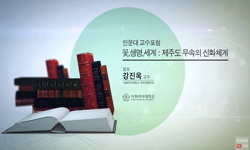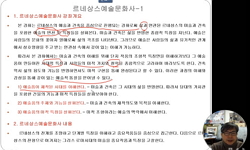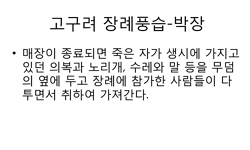이 글을 통해 강진 무위사 극락전의 벽화의 조성배경과 벽화제작을 추진한 세력의 실체, 작품의 내용과 성격을 분석하고자 하였다. 무위사의 벽화가 어떻게 불교가 정치적으로 쇠퇴하던 조...
http://chineseinput.net/에서 pinyin(병음)방식으로 중국어를 변환할 수 있습니다.
변환된 중국어를 복사하여 사용하시면 됩니다.
- 中文 을 입력하시려면 zhongwen을 입력하시고 space를누르시면됩니다.
- 北京 을 입력하시려면 beijing을 입력하시고 space를 누르시면 됩니다.
https://www.riss.kr/link?id=T7949230
- 저자
-
발행사항
광주 : 전남대학교 대학원, 1999
-
학위논문사항
학위논문(석사)-- 전남대학교 대학원: 사학과 1999. 2
-
발행연도
1999
-
작성언어
한국어
- 주제어
-
KDC
911.98 판사항(4)
-
DDC
751.53 판사항(20)
-
발행국(도시)
광주
-
형태사항
51p : 삽도,사진 ; 27cm.
-
일반주기명
지도교수: 김당택
참고문헌수록 - 소장기관
-
0
상세조회 -
0
다운로드
부가정보
국문 초록 (Abstract)
이 글을 통해 강진 무위사 극락전의 벽화의 조성배경과 벽화제작을 추진한 세력의 실체, 작품의 내용과 성격을 분석하고자 하였다. 무위사의 벽화가 어떻게 불교가 정치적으로 쇠퇴하던 조선초기에 조성될 수 있었으며, 그 과정에 참여한 세력은 누구였을까? 여말선초의 정치·경제·사회적 변화들은 회화작품의 창작에 어떠한 영향을 끼쳤으며, 작품 속에 어떠한 예술적 표현방식으로 반영되었는가? 이러한 궁금증에서 이 글을 쓰게 된 것이다.
조선 초 무위사는 자복사와 수륙사로 지정되고 있었다. 1430년(세종 12년)의 무위사 극락전은 이러한 배경하에 건립될 수 있었다. 여기에 효령대군의 지원이 뒤따랐다. 1476년의 극락전 후불벽화의 조성에는 양반과 양인, 승려와 노비 그리고 부녀자 신분이 참여하였다. 성씨별로는 전체 15개의 참여가문중 10개 성씨가 강진의 토착 성씨였다.
극락전의 후불벽화는 아미타극락회도와 백의관음보살도가 후불벽의 전·후면에 각각 그려져 있다. 아미타극락회도는 관경변상도와 그 구성방식이 유사하였다. 고려불화의 기본을 따르면서도, 엄격하던 2단구도가 해체되는 등의 새로운 변화가 시도되었다. 백의관음보살도는 활달하고 속도감 마저 느껴지는 필체와 당당한 자세에서 자못 남성적인 체취를 느낄 수 있어 고려불화의 여성적 이미지의 관음보살과는 다른 화풍을 보여주었다.
극락전 내부의 동·서양 측면에 그려진 설법도와 아미타내영도는 그 구도와 필치 등에서 수종사 금동불감의 아미타극락회도와 거의 유사한 형식을 취하고 있다. 제작시기는 옷매무새·원형두광·자세와 구도 등이 후불벽화보다 古式이기 때문에 후불벽화보다 더 앞서는 것으로 생각된다.
고려불화의 화면을 압도하는 아미타여래의 권위는 곧 고려 문벌귀족의 권위이기도 하였다. 고려불화의 엄격한 2단구도는 고려시대 불교의 지위와 성격을 반영하는 것이었다. 그러나 조선의 개국으로 이러한 제원칙들은 근본적인 도전에 직면하게 되었다. 더 이상 작품을 중앙에서 통제할 수 없었고, 또한 그럴 정치적·종교적 이유도 사라져갔다. 즉, 엄격한 2단 구도를 통해서 아미타여래의 절대적인 권위를 옹호해야 할 회화적 이유가 약화되었다. 무위사 벽화에서 2단구도가 해체되고 마치 대화를 나누는 듯 자연스럽게 화면에 개입하는 승려의 표현이 가능하였던 데에는 여말선초의 시대적 변화가 있었던 것이다. 또한 다양한 종교적 모티브들이 후불벽화에 등장할 수 있었던 것도 다양한 신분의 사람들이 벽화의 조성에 함께 참여하였다는 점을 반영하였다. 조선의 건국으로 불교의 우월했던 지위는 상실되어 갔다. 그러나 성리학적 질서로 조선사회가 완전히 재편되기까지는 좀 더 시간이 필요하였다. 조선 초 무위사 극락전 벽화에서 새로운 회화적 변화가 시도되었지만, 여전히 고려불화의 양식이 기본형이었다는 점은 이러한 맥락에서 이해된다. 즉, 강진 무위사 벽화는 여말선초의 불교계가 처해 있었던 정치적·사회적 변화과정을 반영하였던 것이다.
다국어 초록 (Multilingual Abstract)
A Study on the Buddhist Mural Paintings in Kang-Jin Muwisa This study aims to analyze the background of creating and restoring of the Buddhistic murals of Kuknakjon(極樂殿) at the Muwisa(無爲寺), Kangjin(康津), who actually promoted the work...
A Study on the Buddhist Mural Paintings in Kang-Jin Muwisa
This study aims to analyze the background of creating and restoring of the Buddhistic murals of Kuknakjon(極樂殿) at the Muwisa(無爲寺), Kangjin(康津), who actually promoted the work, and the contents and character of the work.
In the early Chosen dynasty the Muwisa was designated as Jaboksa(資福寺) and Suryuksa(水陸社), Jaboksa took on a political character of absorbing the discontent of the Buddhists with the obliteration of many old Buddhist temples, while Suryuksa performed government-sponsored memorial services for the deceased of the Royal Household. The construction of Kuknakjon at the Muwisa was pushed forward with the aid of Prince Hyoryong(孝寧大君) in 1430, i.e. in the twelfth year of King Saejong's(世宗) reign.
The hind Buddhistic mural of Kuknakjon was done in 1476(i.e, in the seventh year of King Songjong's(成宗) reign). The Amitabba(阿彌陀) and Elysium mural right behind the Buddha statue has an explanation of the paintings with the names of 80 donators attached thereto. The donators for the hind mural can be classified into the ranks beyond yang-in(良人, 'law-abiding citizens'), monks, serfs, and women. Among them the Kangs of Jinju(晋州 姜氏) belonging to Kang Jil(姜□) were relatives of Prince Hyoryong. Besides the Kangs ten cleans of different surnames took part in the creation of the mural.
Inside Kuknakjon there are 32 murals including the hind mural. All murals expect for the hind mural, eastern and western murals were done during the later Chosun dynasty. In the front of the hind mural there is a painting the Amitabba and Elysium with a painting of Kuan-in in the background, Following the basic pattern of Koryo Buddhist paintings, the Amitabba Elysium painting reveals a disintegration of strict two-stage composition and a new variation in the expression of details.
Quan-in dressed in white(白衣觀音) is painted in the background of the hind mural. The liberal and speedy movement of the brush we can perceive in the painting and the stately posture of Quan-in emanates something characteristic of the man in contrast with the femininity of Koryo Buddhist paintings.
Inside Kuknakjon the eastern and western wall has Dialogue painting and Amitabba painting respectively. Along with the western mural, the eastern mural has much the same composition as does the Amitabba painting at the Sujongsa(水鍾寺). Judging from the outward look of the dress, posture, composition, etc., we can safely say the side murals preceded the hind mural.
In Koryo Buddhistic paintings a blank space was something like the air where there lingered the religious spirituality of Tathagata Amitabba. The overwhelming authority of Tathagata Amitabba that dominated the whole pioturo was in itself the authority of the aristocrats of good lineage. The strict two-stage composition characteristic of Koryo Buddhist paintings was thus reflective of the position and character of the Buddhism of the Gory are. With the founding of the Chopin dynasty, however, those fine art principles were faced with radical challenges. The fine art could no longer be controlled from the metropolis, and gone were the politico-religious reasons to do so. In other words, the political, social, and religious reasons for espousing the absolute authority of Taught Amiable by sticking to strict two-stage composition came to be diluted and weakened. The disintegration of strict two-stage composition, the portrayal of monks with natural facial expression, etc. as shown in a refreshing manner in the murals of the Mucosa bore out the trends of the times at the end of the Gory dynasty beginning of the Chosen dynasty.
목차 (Table of Contents)
- 국문초록
- 1. 머리말 = 1
- 2. 극락전의 건립과 孝寧大君 = 4
- 3. 극락전 後佛壁畵의 畵記 분석 = 11
- 가. 화기의 내용 = 11
- 국문초록
- 1. 머리말 = 1
- 2. 극락전의 건립과 孝寧大君 = 4
- 3. 극락전 後佛壁畵의 畵記 분석 = 11
- 가. 화기의 내용 = 11
- 나. 시주자의 신분유형 = 12
- 4. 극락전 내부벽화의 내용과 성격 = 19
- 가. 後佛壁畵
- 1) 阿彌院極樂會圖 = 21
- 2) 白衣觀音菩薩圖 = 28
- 나. 측면벽화
- 1) 阿彌陀來迎圖 = 30
- 2) 說法圖 = 32
- 다. 기타벽화
- 1) 如來圖 = 34
- 2) 菩薩圖 = 35
- 3) 飛天圖·供養花圖 = 36
- 라. 벽화의 성격 = 37
- 5. 맺음말 = 40
- 도판
- 참고문헌
- 영문초록











